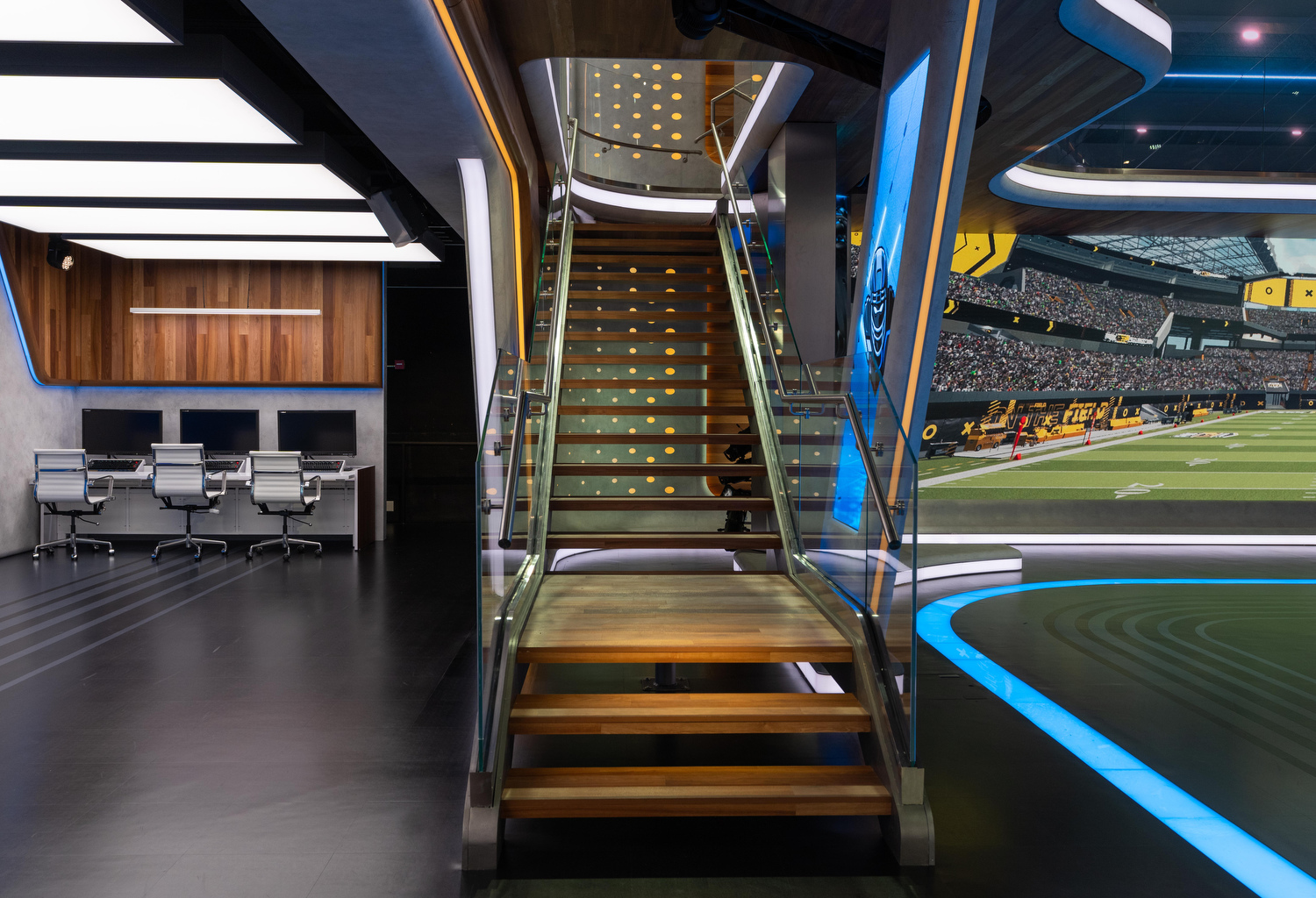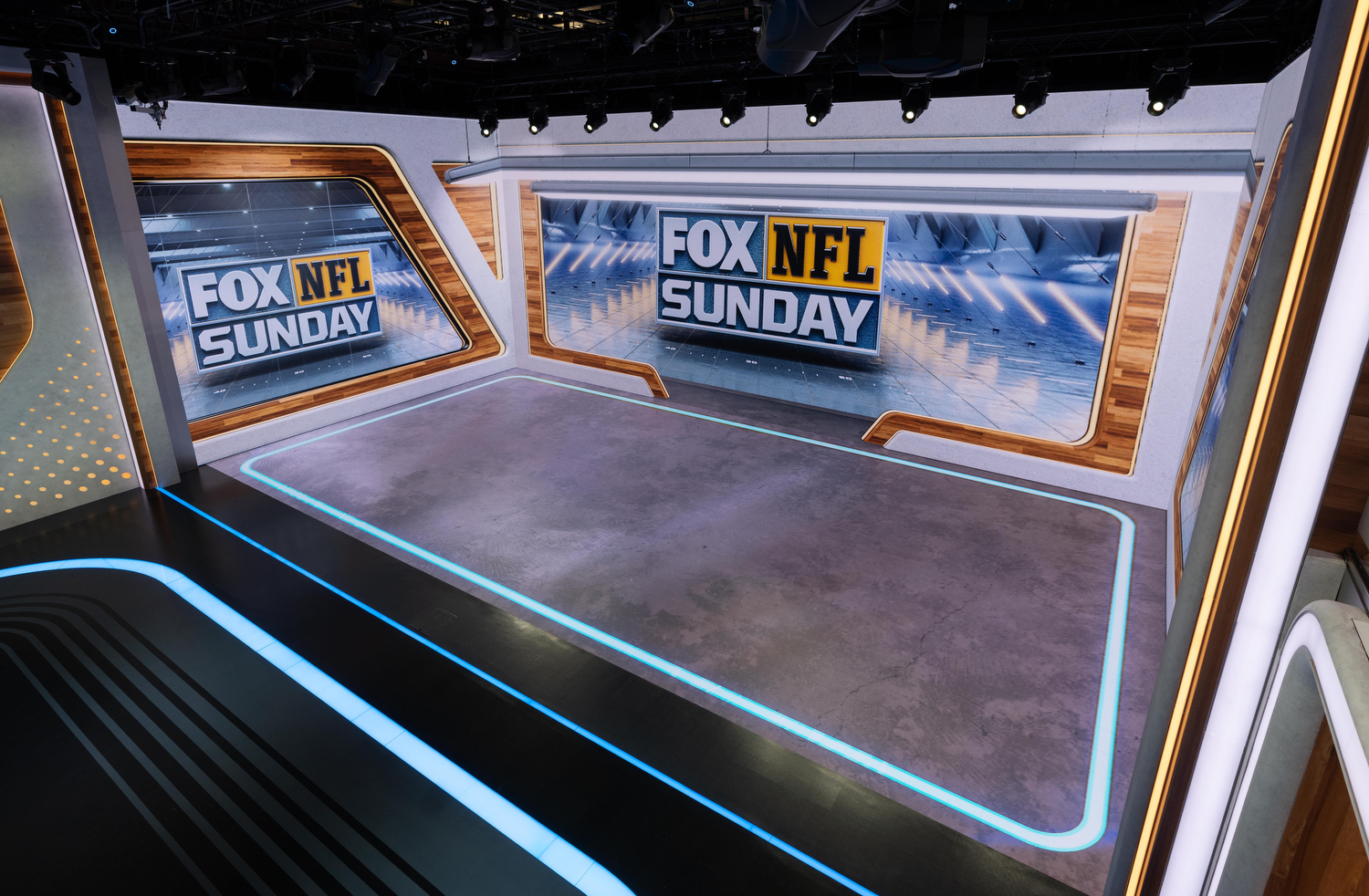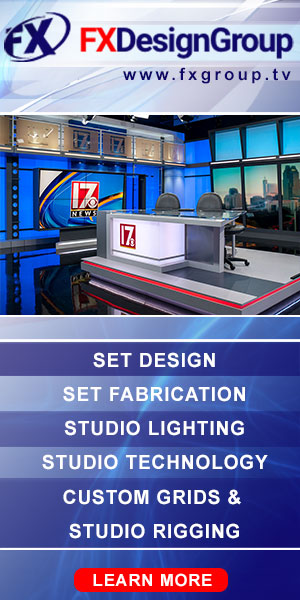Subscribe to NewscastStudio for the latest news, project case studies and product announcements in broadcast technology, creative design and engineering delivered to your inbox.
Fox Sports’ new Los Angeles studio is a crowning achievement in combining hard scenic, video wall graphics, virtual set extensions, and mixed, extended and augmented reality elements.
Built inside of the 5,000-square-foot Studio A as the primary home of Fox’s NFL and MLB coverage, the set features hard scenery on one side of the space with a double-height LED volume on the other.
The hard scenery, from Jack Morton Worldwide, is dominated by honey-colored wood planking and faux concrete structural elements that frame out seamless LED video walls.
“Inspired by the sleek, curvilinear aesthetics of modern stadium architecture, the set maximizes the studio’s potential while pushing its look and functionality far forward,” said Larry Hartman of Jack Morton Worldwide. “With flowing shapes that define the studio, the design dramatically takes full advantage of the space, embracing its immense size and high ceilings, featuring a fully functional second-story mezzanine.”

The primary setup for “Fox NFL Sunday,” which airs before its weekly NFL coverage. The anchor desk can also be positioned to take advantage of the studio’s other LED wall or the area under the balcony.
The set’s primary anchor desk can take advantage of multiple backdrops and is fronted with seamless LED in a custom shape. For “Fox NFL Sunday,” the desk typically sits in front of a two-story video wall framed with curved corners and bisected by an edge-lit continuation of the functional mezzanine above.
This large LED canvas can showcase imagery of stadiums and fields, often modified to feature Fox Sports branding as if it were being shown on the venue’s digital signage.
On either side of this display are two LED columns, each spanning two levels, that typically display subtly-animated depictions of Cletus, the Fox Sports robot mascot.

Camera right of the desk is a wall primarily filled with additional seamless LED framed by angles and curved corners and capped with an internally lit Fox Sports logo featuring edge-lit segments above and below.
Those angles and curved corners are used throughout the space and extended reality elements to create polygon-like shapes in the scenery, a shape that purposefully avoids any reference to a specific sport while channeling the look and feel of Cletus’ shell.

An open staircase leads to the second level. Featuring a glassed-in workstation area surrounded by control room-like monitor walls and an additional video wall venue outside, glass railings here also create an open feel and limit obstructions on the LED wall on wide shots.
Behind the staircase is a wall with circular backlit cutouts in various sizes embedded in a textural gray wall. This echoes background features found on either side of the main anchor desk.

“Fox Sports has always considered its flagship studio to be a ‘working set,’ with producers, researchers, and other support staff visible at workstations in the background,” said Hartman. “‘The Skybox,’ an upper-level workspace enclosed in curving glass, is arrayed with bands of monitors constantly updated with the latest game footage.”
The Skybox also includes carpeting woven with a shifting elliptical pattern, wood and gray accents and a 3D Fox Sports logo.
Below the balcony is an alcove with an additional video wall along with more workstations. The balcony also includes a smaller set with a secondary desk that can be used for smaller productions.
Multiple angled elements in a combination of wood and gray tones contrast dramatically with the angle of the staircase. Portions of these are installed parallel to each other with alternating finishes and integrated edge-lights that continue into the header area. That then flows into a vertical separator between the hard scenic and LED volume.

The LED volume inside Fox’s Studio A was designed and integrated by NEP Sweetwater. The volume’s walls are constructed from ROE Visual’s Black Pearl 2V2 (BP2V2) panels.
The LED volume, which comes in at just over 46 feet wide by about 24 feet deep and 19 feet tall, features four LED surfaces — including the floor — that result in over 5,100 square feet of diodes.
Nicknamed “The Cave,” Fox can use virtual set extensions that mimic the look of the scenery’s walls and floors, including template-driven video-within-video layouts inside the volume. This look allows the virtual and hard scenery to be combined into a single unified look, while also offering the flexibility of changing the look of the volumetric environment for unique segments and events.

It can also be used to place talent inside simulated environments that are less realistic but carry through with many of the same design elements found on the hard set.

In all, 36 Vizrt and Unreal Engines power the space, allowing it to switch between various looks developed with the help of Girraphic.
In the opening broadcast from the space, this included a darker, more fantastical set extension that creates the illusion of an expansive, hangar-like environment. In total, 41 real-time graphics channels can be outputted at any time for the studio’s various video walls and virtual displays.
Fox can also use the LED volume to recreate various other environments (including stadiums and fields), a feature that allows the commentators to recreate plays or illustrate strategy on virtual turf.
“The result is a hybrid environment where the physical and digital backgrounds co-exist and adapt to best support the programming,” said Hartman.
But engineering the hybrid environment took a truly engineered solution to ensure a seamless presentation and adherence to California’s strict seismic building code.
“The entire set is built on an 8-inch high steel deck that fills the studio and allows integrated floor light boxes and the LED tiles to sit flush. This raised deck allows for counterweight for the sizable ‘floating’ portions of the mezzanine level,” said Hartman.
A 60-foot steel beam was added, with rods connecting to the ceiling to provide support for the set structure.

The studio is equipped with Stype camera tracking and GhostFrame’s multi-source technology to bring viewers an additional level of perspective when using the volumetric space.

What the LED volume looks like with GhostFrame activated. Each camera pointed at the volume can be set to only pick up LED elements at a specific refresh rate, ignoring the others. This allows different cameras to have different backgrounds, which is often used to make the virtual environments and imagery more realistic on screen.
GhostFrame allows each camera pointed at the volume to have a unique background layer added in. This means it can output different backgrounds from what the talent natively sees on the LED panels by having different cameras look for the LED pixels set to specific refresh rates and ignoring the others.
Stype is also used in conjunction with more traditional augmented reality elements, including team logos and player photos. Talent can interact with virtual and extended reality elements with their hands or through the use of wireless tablets.
Additionally, Fox Sports upgraded the studio’s lighting grid with eight automated ladder trusses that create an unlimited number of lighting positions without blocking key shots. Each truss includes automated lights and can rapidly move or disappear when not in use.
Photos courtesy of Fox Sports and Raeford Dwyer / Jack Morton.
Project Credits
Fox Sports
Eric Shanks – CEO and Executive Producer
Brad Zager – President of Production and Operations, Executive Producer
Gary Hartley – EVP/Creative Director
Mike Wilken – SVP Systems and Technology
Gina Porretti – SVP Studio Operations
Melissa Garcia – Studio Operations Manager
Daryl Moore – VP FOX Sports Systems Engineering
Michael Dolan – SVP Design
Zac Fields – SVP Graphic Technology and Innovation
Jessica Nguyen – Director Project Management
Chris Smith – Coordinating Producer Real Time Media
Rob Rees – VP Fox Sports Production and Post Production Engineering
Chris Ruiz – Director Fox Sports Production Engineering
Nole Eldridge – Sr. Manager Fox Sports Broadcast Systems Engineering
Trevor Candler – Fox VP Plant Operations and Construction
Lani Matsunaga – Fox Executive Director Plant Operations and Construction
Sigi Soriano – Fox General Foreman Plant Operations and Construction
Jim Vechiarelli – Studio Foreman
Scenic Design – Jack Morton Worldwide
Larry Hartman – Senior Design Director
Jim Fenhagen and Andre Durette – Design Leadership
Evan Hill – Designer/Project Management Director
Chris Maroney – Illustration Art Director
Raeford Dwyer – Graphic Design Art Director
Ben Bauer, Lauren Barber, Derek Van Heel, Daniel Prosky and Graham Caulfield – Drafting
Tristan Howard and Ruth Shorten – Production Support
Virtual Design – Girraphic
Fabrication – Showman Fabricators
Scenic Fabrication, Technical Design, and Installation by Showman Fabricators, Inc.
Bob Usdin – President and Account Executive
Viana Segarra – Project Manager
Katy Lai, Novella De Angelis, Project Coordinators
Drew Farrow – Lead Technical Designer
Kelly Fayton-Hrdy, Ashley Haughwout, Colin Nickel, Ben Frechette Technical Designers
Mike Riccio Director of Technical Design
Chris Meems, Director of Production
Lucas Hickman, Chris Dono, Dave Marcus, Chris Ciociano, Foremen
Aris Paganakis – Lead Carpenter/Installation Lead
Chase Brooks – Lead Automation/Scenic Lighting Technician
Henry Morales – Installation Technician
Dylan Kaye- Onsite Scenic Charge
Tony Menditto, B.R. Delaney, Ted Wondsel, Lead Rigging Team
Elliot Bertoni, Show Deck Installer
Serge Gountas Automation and Electrics Department Head
Spencer Padilla, Automation and Electrics Department Lead
Ryan Poethke, Automation and Electrics Department Detailer
Chase Brooks, Automation and Electrics Shop Lead and Installation Tech
Jennifer Orellana, Scenic Charge
Sami Adamson, Scenic Second
Cory Einbinder, Graphics Department Head
Waring Webb, CNC Department Head
Engineering Consultation – Clark Reder
Daniel J. Clark, P.E.
Additional scenic fabrication by IDF Studio Scenery.
Lighting Design – Airtime Lighting Group
Jeffry Gregson – Lighting Consultant/Designer
Dave Thibodeau – Lighting Design/Lighting Director
James Beaghan – Gaffer
AV Integration – NEP Sweetwater
Ron Drews – President
Chris Mitchell – Director of Special Projects
Greg Correia – Project Manager
Bill Hodson – Systems Integration
Zachariah Bellomy – LED Lead
Thomas Sean Bartley – LED Lead
Darren Correll – LED Lead
Hugo Pineda – LED Lead
Steven Kozakowski – LED Lead
Michael Grubbs – LED
Joey Di Benedetto – LED
Jared Gaxiola – LED
Michel Rodriguez – LED
Austin Cardenas – LED
Leigth Mitcheltree – Director of Buisness Operations
Hank Tracy – Director of Project Management
Subscribe to NewscastStudio for the latest news, project case studies and product announcements in broadcast technology, creative design and engineering delivered to your inbox.




